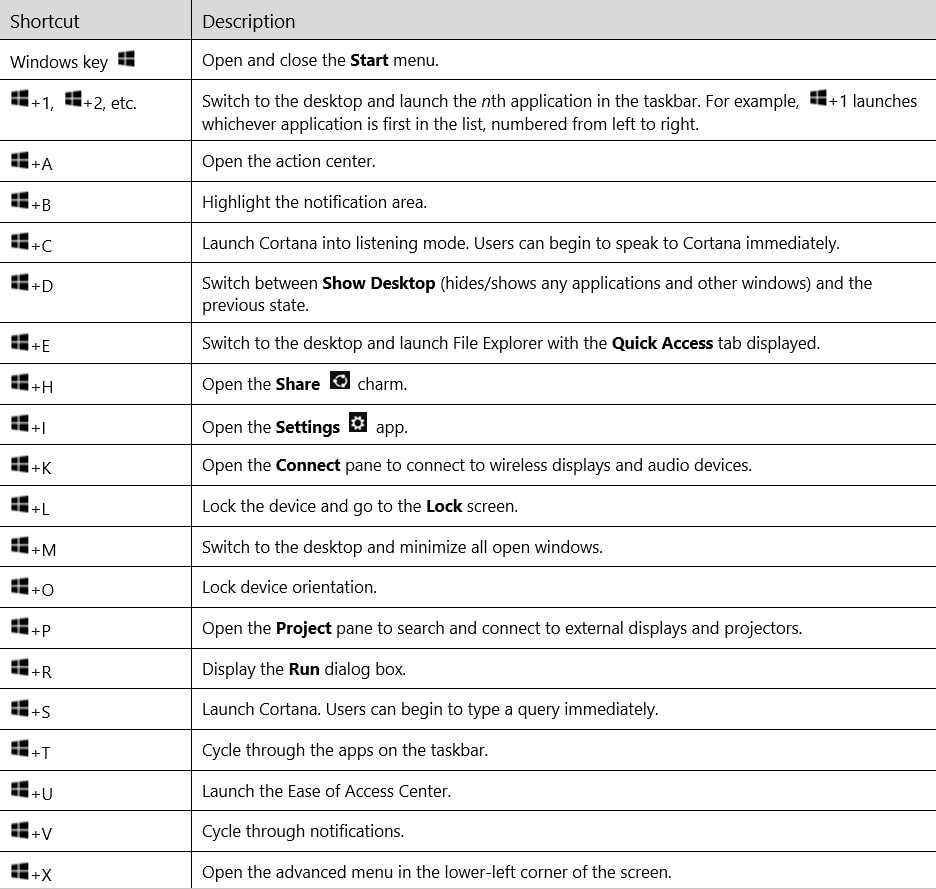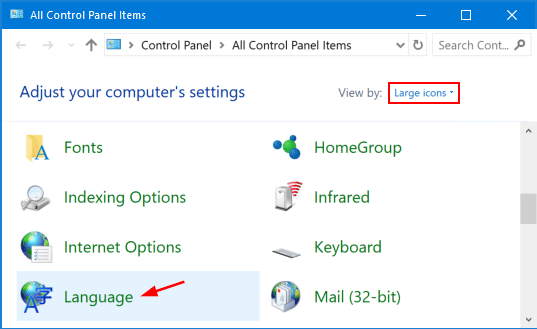A new focus on the desktop brings new keyboard shortcuts for desktop users, so rejoice! Here are all the new keyboard shortcuts you need to know in Windows 10.
How to Create Keyboard Shortcuts in Windows 10 Method 1: Creating Shortcut Key Using Start Menu In this method, you can create shortcuts for any desktop application in a few clicks. Therefore, follow this step by step to create custom shortcut key in your Windows 10. Dec 12, 2018 There are a number of built-in keyboard shortcut options in Windows 10, and there are also powerful third-party tools that will give you access to more options. In this article, I will give you a tutorial on using both these approaches to creating Windows 10 custom hotkeys. Adding Hotkeys to Program and Website Desktop Shortcuts. For those of you who have been wanting to know the list of keyboard shortcuts in Windows 10, here it is. I've tested these shortcuts, including accessing Cortana, moving from virtual desktop to.
From window management with Snap and Task View to virtual desktops and the Command Prompt, there are lots of new goodies for keyboard users in Windows 10.
General Use Shortcuts
Windows 10 introduces a number of new shortcuts for controlling general aspects of your environment:
- Windows+A: Open the Action Center.
- Windows+I: Open Windows Settings.
- Windows+S: Open Cortana.
- Windows+C: Open Cortana in listening mode.
You can achieve all these actions with your mouse, too, of course, but where’s the fun in that?
Window Snapping Shortcuts
RELATED:4 Hidden Window Management Tricks on the Windows Desktop

Change Keyboard Shortcuts Win 10
Windows 10 offers improved support for Snap, known as “Aero Snap” on Windows 7. You can now snap windows vertically—one on top of each other, instead of side-by-side—or snap windows to a 2×2 grid.
- Windows+Left: Snap current window to the left side of the screen.
- Windows+Right: Snap current window the the right side of the screen.
- Windows+Up: Snap current window to the top of the screen.
- Windows+Down: Snap current window to the bottom of the screen.

Combine these shortcuts to snap a window into a corner. For example, pressing Windows+Left and then Windows+Up would snap a window into the top-left quadrant of the screen. The first two keyboard shortcuts aren’t new, but the way they work with the 2×2 snapping feature is.
You can also use the mouse, of course. Drag a window by its title bar to the edges or corners of your screen. A highlighted area shows you where the window will rest when you let go of the mouse button.
Task View and Window Management Shortcuts
Task View is a new interface that combines Exposé-like window switching and virtual desktops—an awful lot like Mission Control on Mac OS X. You can click the “Task View” button on the taskbar to open it, or you can use these keyboard shortcuts:
- Windows+Tab: This opens the new Task View interface, and it stays open—you can release the keys. Only windows from your current virtual desktop appear in the Task View list, and you can use the virtual desktop switcher at the bottom of the screen to switch between virtual desktops.
- Alt+Tab: This isn’t a new keyboard shortcut, and it works just like you’d expect it to. Pressing Alt+Tab lets you switch between your open Windows. With the Alt key still pressed, tap Tab again to flip between windows, and then release the Alt key to select the current window. Alt+Tab now uses the new Task View-style larger thumbnails. Unlike Windows+Tab, Alt+Tab lets you switch between open windows on all virtual desktops.
- Ctrl+Alt+Tab: This works the same as Alt+Tab, but you don’t have to hold down the Alt key—the window thumbnails stay on screen when you release all the keys. Use Tab or your arrow keys to move between thumbnails. Press Enter to select the current thumbnail and make that window active.
Creating Keyboard Shortcuts Windows 10 Not Working
Virtual Desktop Shortcuts
RELATED:How to Use Virtual Desktops in Windows 10
There are also some keyboard shortcuts for quickly managing virtual desktops.
Create Keyboard Shortcuts Windows 10

- Windows+Ctrl+D: Create a new virtual desktop and switch to it
- Windows+Ctrl+F4: Close the current virtual desktop.
- Windows+Ctrl+Left/Right: Switch to the virtual desktop on the left or right.
Sadly, there’s not yet a key combination that moves the current window between virtual desktops. How about Windows+Shift+Ctrl+Left/Right—please, Microsoft?
Command Prompt Shortcuts
RELATED:How to Power Up the Windows 10 Command Prompt with CTRL+C and CTRL+V
The new Command Prompt keyboard shortcuts may not be enabled by default, so be sure to open the Command Prompt’s properties window and enable them first.
Create Keyboard Shortcuts Windows 10 Fn Key
Shortcuts for Copying and Pasting Text at the Command Prompt
- Ctrl+V or Shift+Insert: Pastes text at the cursor.
- Ctrl+C or Ctrl+Insert: Copies the selected text to the clipboard.
Shortcuts for Selecting Text at the Command Prompt
RELATED:42+ Text-Editing Keyboard Shortcuts That Work Almost Everywhere
Many of the standard Shift key shortcuts for text editing now finally work in the Command Prompt! These shortcuts include:
Change Chrome Keyboard Shortcuts Windows 10
- Ctrl+A: Select all text in the current line if the line contains text. If it’s an empty line, select all text in the Command Prompt.
- Shift+Left/Right/Up/Down: Moves the cursor left a character, right a character, up a line, or down a line, selecting the text along the way. Continue pressing arrow keys to select more text.
- Ctrl+Shift+Left/Right: Moves the cursor one word to the left or right, selecting that word along the way.
- Shift+Home/End: Moves the cursor to the beginning or end of the current line, selecting text along the way.
- Shift+Page Up/Page Down: Moves the cursor up or down a screen, selecting text.
- Ctrl+Shift+Home/End: Moves the cursor to the beginning or end of the “screen buffer,” selecting all text between the cursor and the beginning or end of the Command Prompt’s output.
More Command Prompt Shortcuts
Custom Keyboard Shortcuts Windows 10
- Ctrl+Up/Down: Moves one line up or down in the Command Prompt’s history — it’s like using the scroll bar.
- Ctrl+Page Up/Page Down: Moves one page up or down in the Command Prompt’s history — it’s like scrolling even farther.
- Ctrl+M: Enter “mark mode,” which helps for selecting text. Previously, the only way to do this was by right-clicking in the Command Prompt and selecting Mark. Thanks to the new Shift key shortcuts, this mode is no longer as important.
- Ctrl+F: Opens a Find dialog for searching the Command Prompt’s output.
- Alt+F4: Closes the Command Prompt window.
Remove Custom Keyboard Shortcuts Windows 10
Microsoft will hopefully add even more keyboard shortcuts as they continue developing Windows 10. And if you’re hungry for more Windows keyboard shortcuts right now, we’ve got you covered:
Image Credit: N I c o l a on Flickr
READ NEXT- › How to Manage Multiple Mailboxes in Outlook
- › How to Move Your Linux home Directory to Another Drive
- › Just Updated to iOS 13? Change These Eight Settings Now
- › How to Create a Local Account While Setting Up Windows 10
- › What Is Windows 10X, and How Is It Different?